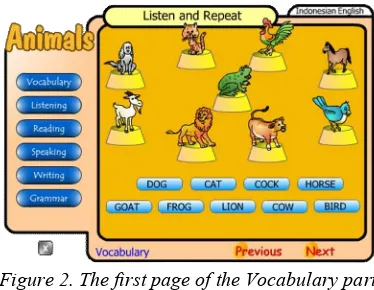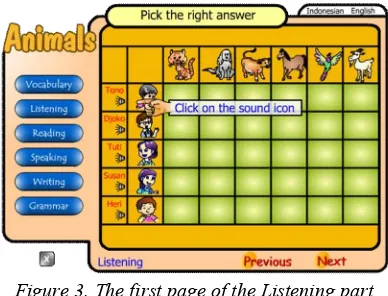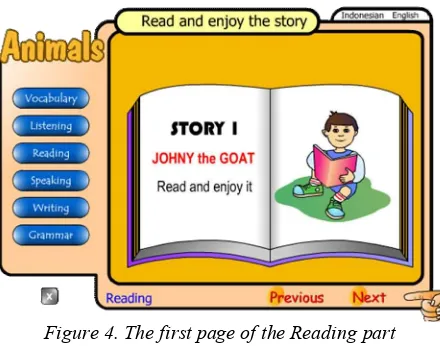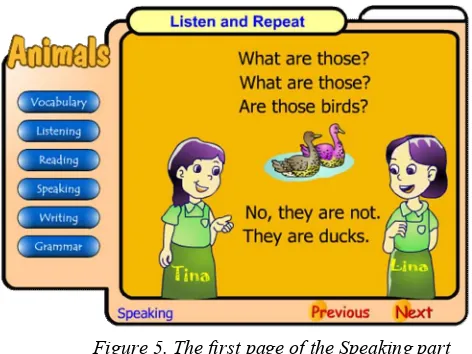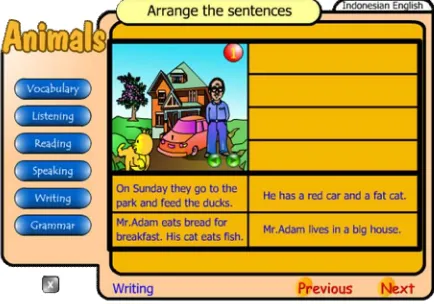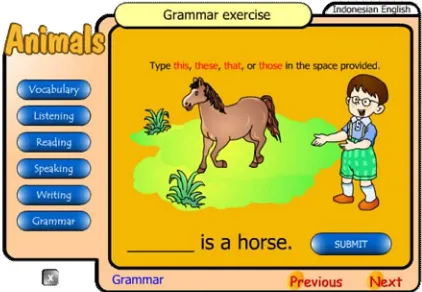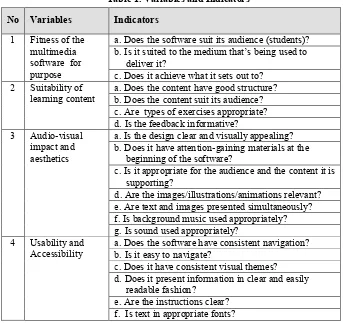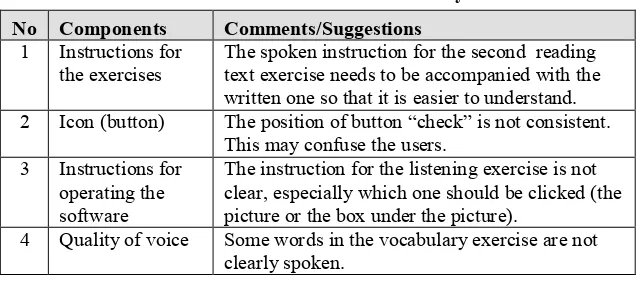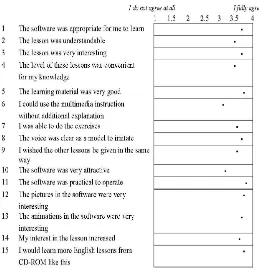Developing Interactive Multimedia Software for English Learning
Y.G. Harto Pramono
Abstract. This paper describes a project aimed to develop interactive multimedia software which is pedagogically attractive and appropriate for Year 2 students of Elementary School to learn English. The software was developed using Macromedia Flash Professional 8. It presented one common theme: Animals. The learning activities provided in the software were carefully designed to help the students develop the four main skills for language acquisition – listening, speaking, reading, and writing – in an integrated way. To gain an optimal product, an evaluation by experts was conducted and the result of this evaluation was used as the basis for revising the software. In addition, a series of tryout by target users were conducted phase by phase. After each phase of the tryout was completed, the software was revised by addressing the results of the tryout to improve its quality. Based on the result of the final tryout, it can be concluded that the developed interactive multimedia software is pedagogically quite attractive and appropriate to help Year 2 students of elementary school learn English.
Keywords: interactive multimedia, learning software, animals, attractive, appropriate,
Introduction
pedagogically attractive and appropriate for the students of elementary school to learn English and enhance their learning achievement.
Interactive multimedia learning software offers potential benefits to teachers for delivering instruction. Studies have also shown that interactive multimedia can help people learn more effectively than traditional classroom instructions. Several factors have been attributed to the success of multimedia in helping students learn. First, there is a parallel between multimedia and the ‘natural’ way people learn. This is due to the dual coding aspect of the information processing theory (Gagne, Briggs, & Wager, 1988). Dual coding refers to using more than one code in the learning process. Dual coding aids learning in terms of allowing a person to absorb information from the environment using two channels, and also in reducing cognitive load in a person’s working memory. Second, information in interactive multimedia is presented in a non-linear hypermedia format that allows learners to view things from different perspectives. Also, hypermedia systems allow users to choose information freely. Third, multimedia offer interactivity that allows learners to give responses and get feedbacks. Fourth, multimedia offer flexibility in terms of how they may be used at home, in classrooms, by individuals or small groups.
In this paper the designing of interactive multimedia software applied for developing an interactive multimedia software for English learning entitled “Animals” under the study will be described. Furthermore, the results of a series of evaluation/tryouts aimed to improve the quality of the developed software and the students’ opinions about the developed software will be presented.
Multimedia Instructional Design
Multimedia design is quite often created by intuition. Therefore, it is unsurprising that multimedia software found in the market is not always effective to enhance learning. To produce effective multimedia software, the multimedia designer should carefully design the multimedia instruction. There are two important issues that need to be considered when designing multimedia instruction. The first is concerned with how structured the information should be and the second is what type of structure is most appropriate for the application and how the structure should be designed (Uden, 2002).
The Structure of Instructional Content
achievement through self-learning by which they can practice their English with minimum help from their teachers.
Figure 1. The first page of the interactive multimedia software
The instructional content for the theme “Animals” is organized into 6 parts: vocabulary, listening, reading, speaking, writing and grammar (Figure 1). In this lesson, the students are going to learn animal-related words which are presented, first of all, in isolation (specifically in the vocabulary part) and then the words are presented in context (throughout the listening, reading, speaking and writing parts). The language focus is presented in a Grammar part. Basically, each part presents information to learn and an exercise or some exercises to reinforce the students’ understanding of the lesson learned and enhance their language skills. The students’ answers to the exercises are given feedback whether they are true of false. Spoken instructions (in English and Indonesian) are provided in each part of the lesson telling the students what to do.
Figure 2. The first page of the Vocabulary part
again and repeat it. Exercises are given to enhance the students’ vocabulary of animal names. In the listening part, the students can hear information about what animals each person likes and what he or she does related to the animals. The exercise in the listening part assesses the students’ understanding of the information they have heard. In the reading part, the students are given two reading passages with animal-related topic. The reading text is accompanied with animated illustrations and a spoken text that can be reheard if the written text is clicked. The animated illustrations are intended to help the students understand the ideas in the text and to arise their motivation. Exercises are given after each text and the students are required to answer the questions. Feedback for the students’ answers are provided informing them whether their answers are right or wrong. In the speaking part, the students are provided with a conversation between two people talking about what the animals are. Special grammatical elements are emphasized. A song about animals is provided here to reinforce the students’ mastery on animal vocabularies and to enhance their learning motivation. In the writing part, two exercises are provided. The first exercise is intended to enhance the students’ spelling ability of animal names, whereas the second exercise is to enhance the students’ ability in describing animal-related pictures. Spoken texts are accompanying the written texts of these exercises. In the last part, Grammar, the students are introduced the language focus used throughout the lesson and are given exercises that may enhance their mastery on the language focus. Written and spoken texts are provided in the grammar part.
Figure 3. The first page of the Listening part
Figure 4. The first page of the Reading part
The Design Features of the Developed Multimedia Software
According to Schnotz (2001) multimedia concerns the combination of multiple technical devices (i.e. computers, electronic memories, information transfer networks, and display devices) in order to present information with multiple presentation formats (like texts, realistic pictures or graphs) through multiple sensoric modalities. Accordingly, the concept of multimedia software refers to three different levels: (a) first, a technical level that refers to the technical devices; these technical devices can be considered as the carriers of signs; (b) second, a semiotic level that refers to the forms or representation (i.e. texts, pictures, and graphs); these forms of representation can be considered as the types of signs; and (c) third, a sensoric level that refers to the sensoric modality of sign reception.
Figure 5. The first page of the Speaking part
Accordingly, the software developed through this study has its design features related to those three levels of multimedia concept. Each level is described below.
Technical level
With regard to the technical level, the developed interactive multimedia software provides:
- Interactivity by which the students can select information, manipulate and investigate the materials through active, self-directed exploratory learning;
- Non-linearity by which the students can make a choice. Semiotic level
In terms of semiotic level, the developed interactive multimedia software providesmultiple forms of representationas follows:
- The information is presented with text and is illustrated by pictures (static or animated) in order that the text information is understood and remembered better, and also to make the learning fun.
- The text and pictures are made coherent and the corresponding information are presented according to the principles of spatial and temporal contiguity (Mayer, 2001). To be specific, related verbal and pictorial information are presented simultaneously throughout the software.
- Some images used in the software are static and some others are animated. Animation is used to direct the learners’ attention to important aspects of the content. However, animation is also used to attract the students’ interest.
Sensoric level
- Background music intended to establish an environment that relaxes the body and prepares the mind for stimulation (Sigman, 2005).
- Different modalities (the visual and auditive modalities) providing the students with the pronunciation model of the target words.
Figure 6. One of the activities in the Writing part
Multimedia Developmental Phases
This interactive multimedia software under the study was developed through 8 phases as follows:
a. Analysis and project planning - including needs analysis, objectives and specifications for resources and equipment. b. Design and authoring - developing overall design, lessons,
production sheets and creating materials and incorporating media.
c. Pre-production - developing specifications for all materials. d. Production - phase during which all materials are produced. e. Post-production - includes editing and special effects. f. Mastering the final program on CD-ROM.
g. Integration and testing - debugging the system, testing the system to ensure it functions correctly.
Figure 7. One of the activities in the Grammar part
Validating the Developed Interactive Multimedia Software
Validating educational multimedia is highly recommended prior to its publication. In this study, validating the developed interactive multimedia software was meant to prove its validity empirically by conducting field evaluation (Burke, 1982). The aspects to be evaluated consisted of: (a) fitness of the multimedia software for purpose, (b) suitability of learning content, (c) audio-visual impact and aesthetics, and (d) usability and accessibility. Four phases were conducted in validating the software: (a) evaluation/verification by experts, (b) individual tryout, (c) small group tryout, and (d) field tryout (Dick & Carey, 2005).
Subjects
For the expert evaluation, the subjects involved were 1 expert of English, 1 expert of instructional technology, and 1 expert of educational software design. Through the expert evaluation, concept clarification and product specification was then established. For the tryouts, the subjects involved were as follows:
a) Individual tryout involves: 3 Year 2 students of an elementary school.
b) Small group tryoutinvolves: 9 Year 2 students of an elementary school.
c) Field tryoutinvolves: 20 Year 2 students of an elementary school.
Variables and Indicators
The evaluation by experts intended to validate the developed multimedia software was based on variables and indicators as presented in Table 1 (adapted from www.aimia.com). This rubric was to assess the acceptability and suitability of each component in the software.
Table 1. Variables and Indicators
No Variables Indicators
1 Fitness of the multimedia software for purpose
a. Does the software suit its audience (students)? b. Is it suited to the medium that’s being used to
deliver it?
c. Does it achieve what it sets out to? 2 Suitability of
learning content
a. Does the content have good structure? b. Does the content suit its audience? c. Are types of exercises appropriate? d. Is the feedback informative? 3 Audio-visual
impact and aesthetics
a. Is the design clear and visually appealing? b. Does it have attention-gaining materials at the
beginning of the software?
c. Is it appropriate for the audience and the content it is supporting?
d. Are the images/illustrations/animations relevant? e. Are text and images presented simultaneously? f. Is background music used appropriately? g. Is sound used appropriately?
4 Usability and Accessibility
a. Does the software have consistent navigation? b. Is it easy to navigate?
c. Does it have consistent visual themes? d. Does it present information in clear and easily
Instrument and Data Collection Techniques
To determine the theme/topic of the lesson, the writer used documentations and needs assessment questionnaire. To collect the data for determining the topic, the writer used survey and interview. To collect data as the basis for revising the product, a questionnaire was used. The questionnaire had closed and open formats and asked about the following aspects: (a) fitness of the multimedia software for purpose, (b) suitability of learning content, (c) audio-visual impact and aesthetics, and (d) usability and accessibility. The techniques used to collect the data were observation, survey, discussion, consultation, and interviews. Data Analysis
There were two types of data obtained through the study. The first data were responses to the open format questions (in the form of inputs, comments and suggestions). These data were analysed according to emergent categories. The second data were responses to the closed format questions (in the form of scores from 1 to 4). These data were analysed based on the frequencies. The results of the analysis were used as the basis for product revision phase by phase to improve the quality of the product.
Results and Discussion
As mentioned previously, to validate the product, an evaluation by experts and a series of tryouts were carried out. The results are presented in the following sequence: (a) results of product evaluation by experts and (b) results of a series of product tryouts by target users.
Results of Product Evaluation by Experts
Tabel 2. Results of the Evaluation by Experts
- The software suits the students.
- The software is an appropriate medium to in Surabaya, it might be difficult for those in the villages or suburbs.
2 Suitability of learning content
- The content has a good structure.
- The content suits its audience. However, there are some words that might be very difficult for students. - The types of exercises
are appropriate. - The feedback is
informative enough.
The reading materials may be too difficult for the students of some particular schools, especially the ones having low quality. It could be better if for some difficult words, the glossary is provided. It would be
helpful for the students having low ability.
3 Audio-visual impact and aesthetics
- The design is clear and visually appealing. - It has attention-gaining
materials at the beginning page of the software and it might be attractive for the students.
- It is appropriate for the audience and the content - The background music
used is appropriate. - The sound is also used
appropriately.
No Variables Opinions Suggestions
4 Usability and Accessibility
- The software has consistent navigation. - It is easy to navigate. - It has consistent visual
themes.
- Most text fonts are appropriate, but the types and size of some fonts need
adjustment.
- Some font types look distracting, and are difficult to read. They need to be changed with font types that are easy to read.
- Some font size needs to be made bigger.
- Some words are misspelled, such as: gras (for grass), medow (for meadow), steam (for stream).
The results of the expert evaluation (Table 2) in summary showed that (i) the developed multimedia software fitted its purpose, (ii) the learning content suited its target users, (iii) the audio was clear enough and the visuals were appealing, and (iv) the software had consistent navigation and the materials were easy to access.
Apart from the positive opinions presented above (Table 2), there were comments and suggestions given by the experts as follows.
a. Regarding the fitness of the multimedia software for its purpose, some of the experts thought that some materials of the software might have been difficult for the students living in the villages or suburbs. According to the writer, it was impossible to select materials which were applicable to all schools in the cities as well as the villages. Even for the cities alone, it was impossible to provide materials which were applicable for all schools. So, the experts’ suggestion regarding this matter was not acceptable. The materials of the software should have been expected to be applicable for the school used as the subject of the tryout. The software might have been applicable for other schools having similar characteristics with the school used as the subject of the tryout. Therefore, in terms of the level of difficulty, the materials of the software was not revised or adjusted.
b. Regarding the suitability of learning content, the suggestion given by some of the experts that a glossary should be provided for some particular difficult words was acceptable. Therefore, revision was made accordingly. For example, for the reading materials, some words were given the glossary (Indonesian).
animated lyrics like karaoke. The idea was acceptable as animated lyrics could have made it easier for the students to read the text. Therefore, the static lyrics was then animated.
d. Regarding the usability and accessibility, some of the experts thought that a particular font type was not easy to read and some font size was too small. In addition, some words were misspelled. This was a reasonable idea and, therefore, adjustment was made accordingly.
The first revision of the product was done by considering the comments/suggestions given by the experts as discussed above.
Results of Product Tryouts by Target Users
After the first revision had been done based on the comments and suggestions obtained through the expert evaluation, the product was then evaluated again through a series of tryouts. The results of the tryouts are presented below.
Results of the Individual Tryout
The individual tryout involved 3 students. The goal was to identify and find out small errors (for instance, mistyping, misspelling), unclear language and instruction for operating the software that might have occurred. Below is the results of the individual tryout as summarized in Table 3.
Table 3. Results of the Individual Tryout
No Components Comments/Suggestions
1 Instructions for the exercises
The spoken instruction for the second reading text exercise needs to be accompanied with the written one so that it is easier to understand. 2 Icon (button) The position of button “check” is not consistent.
This may confuse the users. 3 Instructions for
operating the software
The instruction for the listening exercise is not clear, especially which one should be clicked (the picture or the box under the picture).
4 Quality of voice Some words in the vocabulary exercise are not clearly spoken.
Comments/suggestions obtained through the individual tryout as presented in Table 3 were logical and so the second revision was made accordingly.
Results of the Small Group Tryout
second revision had been made. The results of the small group tryout is presented in Table 4.
Table 4. Results of the Small Group Tryout
No Components Comments/Suggestions
1 Instructions for exercises
The written instruction for the reading exercise is not exactly the same with the spoken one. 2 Quality of sound The volume of the background music for the
“vocabulary” exercise is too much louder than the sound of the words, so the words are not clearly pronounced.
Comments/suggestions given by the students through the small group tryout related to only two aspects, i.e., the instruction for exercises and the quality of sound as presented in Table 4. As all of the comments/suggestions given by the respondents were acceptable, therefore the product was then revised accordingly (third revision).
Results of the Field Tryout
After the developed software had been revised for three times, the product was ready to be tried out to user-candidates in a larger group (field tryout). The software was tried out to 20 students. In the field tryout, the students were given a questionnaire with 15 statements expressing a positive point of view. The students were required to give their opinions. The opinion scale was expressed by four categories:
· I fully agree · I partly agree
The results of the field tryout can be examined in Table 5.
Table 5. Results of the Field Tryout
The results of the field tryout (Table 5) showed that the software was appropriate for them to learn and quite attractive. They found the lesson understandable and very interesting. They also found the learning materials very interesting. They agreed that the level of the lesson was convenient for their knowledge and the voice in the software was clear as a model to imitate the pronunciation of the words presented. They also agreed that they were able to do the exercises and use the multimedia instruction without additional explanation. They also wished that the other lessons would be given in the same way. The students found the pictures and animations in the software very interesting and the software was easy to operate. They also agreed that their interest in the lesson increased when they were using the software and would like to learn more English lessons from CD-ROM like this.
one of English learning resources for Year 2 students of elementary school, particularly for the schools in Surabaya having similar characteristics with the school used as the subject of the tryout.
It can be explained why the developed software turned out to be an appropriate one for the target users. Firstly, the developed software was developed based on the needs of the target users gathered through needs assessment. Secondly, it had been evaluated by experts and tried out to the target users for three times. The results of the evaluation and tryouts had been used as consideration for revising the software. Thirdly, the content structure was designed carefully to suit the students’ needs and make it understandable. Fourthly, it was developed based on the theory of multimedia. Mayer (2001) defines multimedia learning as learning from words and pictures. This study was concerned with dual-channel assumption, which is based on people having two separate information processing channels: one for visual represented materials and the other for auditory represented materials. In other words, the software provides two different modalities (the visual and auditive modalities) which is underpinned by the principle that information that enters through multiple sensoric modalities is better understood and remembered than through one sensoric modality (eye or ear) only. Fifthly, the software was designed by addressing multimedia concepts suggested by Schnotz (2001), i.e., non-linearity and interactivity which allow the learners to select information, manipulate and investigate a learning activity through active, self-directed exploratory learning. The inclusion of these facilities in the software could enable learners to learn the materials in accordance with the level of their cognitive capacity, their interest, and difficult parts that may be their priority to learn. Finally, the instructional activities of the software are designed in a way that can be fun for the students and make learning easy. The use of audio and animated pictures in the software may also increase enjoyment and engage the students in a way that static material does not (Cairncross & Mannion, 2001). The provision of these facilities can be attractive for the students to learn and foster their understanding and retention of the materials they have learned.
Conclusion
of the interactive multimedia software developed, (b) the students involved in the tryouts could learn English well from the software, and (c) the software was quite attractive and all the students were interested in learning English through the software. Based on these results, the developed multimedia software could be used as one of pedagogically attractive and appropriate English learning resources for Year 2 students of elementary schools.
References
Cairncross, S., & Mannion, M. (2001). Interactive multimedia and learning: Realizing the benefits. Innovation in Education and Teaching International, 38(2), 156-164.
Dick, W., & Carey, L. (2005). The Systematic Design of Instruction (6th ed.). London: Scott, Foresman and Company.
Gagne, R. M., Briggs, L. J., & Wager, W. W. (1988). Principles of Instructional Design. London: Holt, Rinehart & Winston.
Judging Criteria, [online] Available: http://www.aimia.com. [retrieved 2009, January 12].
Schnotz, W. (2001).Educational promises of multimedia learning from a cognitive perspective. Paper presented at the 9th European Conference on Research on Learning and Instruction (EARLI), Fribourg/Switzerland.
Sigman, K. J. (2005). Using Background Music in the Classroom to Effectively Enhance Concentration Within the Learning Environment. Unpublished master's thesis. Graduate School of Marietta College.
Uden, L. (2002). Designing hypermedia instruction. In P. L. Rogers (Ed.), Designing instruction for technology-enhanced learning (pp. 161-183). London: Idea Group Publishing.
